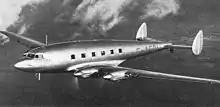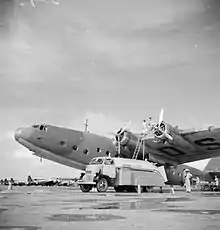Speedbird
The Speedbird is the stylised emblem of a bird in flight designed in 1932 by Theyre Lee-Elliott as the corporate logo for Imperial Airways. It became a design classic[1] and was used by the airline and its successors – British Overseas Airways Corporation and British Airways – for 52 years. The term "Speedbird" is still the call sign for British Airways.

History
Imperial Airways
The original Speedbird was designed in 1932 for Imperial Airways by Theyre Lee-Elliott.[2] It was initially used on advertising posters and luggage labels.[3] Later, it was applied to the nose section of the company's aircraft and could be seen for example in 1938 on the company's Short S.30 improved C-class flying boats.[4]
BOAC
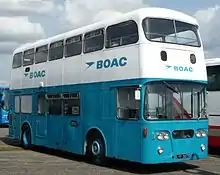
With the creation of BOAC in 1939 the logo was retained, continuing to appear on the noses of aircraft throughout World War II despite the military-style camouflage that had replaced the airline livery.
From 1950 BOAC gave the Speedbird greater prominence on the aircraft using it on the tail fin, either in navy blue on a white background or vice versa, and also using it widely elsewhere, such as on airport buses.
With the advent of air traffic control and the adoption of call signs to identify aircraft and their operators, BOAC chose the name of their now well-known logo, "Speedbird", as their call sign when in flight.
In the mid-1960s the design of the Speedbird was slightly altered, with a slimmer "body" and larger "wing", and on the tailfin coloured gold on a navy blue background. Elsewhere the colours used for it were mostly a combination of cyan and white.
British Airways

In 1974, BOAC was merged with British European Airways and others to form British Airways. The speedbird logo was retained unaltered, but returned to the nose section of the aircraft. A prominent Union Flag design now occupied the fin.
The Speedbird survived for another ten years, finally being retired in 1984.
Current use
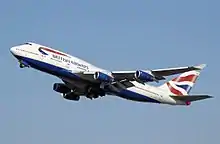

As British Airways prepared for privatisation, a new corporate look was adopted in 1984, developed by Landor Associates. Referred to as the Speedwing, the red flash on the lower dark blue part of the fuselage bore a slight resemblance to the original 1930s design. The current Speedmarque ribbon bears a tangential resemblance to the original Speedbird. "Speedbird" continues to be used by British Airways as the ICAO callsign for its main international services.[5] On its domestic services, it uses the callsign "Shuttle".[6]
Hatton Cross tube station (open 1975) still has "Speedbird" decorating its platform pillars.
In 2019, the Speedbird emblem returned to use by British Airways with the unveiling of their BOAC-liveried Boeing 747-400 retrojet to celebrate 100 years of BA and its predecessors.[7][8]
Design significance
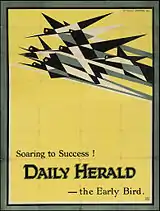
Theyre Lee-Elliott was a graphic artist and painter working in London in the 1930s.
The Speedbird is among his best known works. The minimalist, stylish and avant-garde design representing a bird in flight it is instantly recognisable and has a timelessly modern appeal.[9]
Lee-Elliott was influenced by the avant-garde work of Edward McKnight Kauffer and the logo echoes Kauffer's angular bird forms in his 1918 poster for the Daily Herald.[10]
Other notable works by Lee-Elliott include posters for the London Underground and the Airmail logo.[3][11] Many of his paintings and original artworks are in the collection of the Victoria & Albert Museum.
Other Speedbirds
A somewhat different Speedbird logo was designed for Piedmont Airlines in 1948.[12][13]
Speedbird House was an office block at Heathrow Airport. It was originally the headquarters of BOAC and, until the company moved, of British Airways.
Speedbird Way is a road near the Colnbrook Bypass, close to Heathrow Airport.
Speedbird is also the name of one of the British Airways Sailing Club yachts.[14]
References
- "Heraldry of Air Transport", Flying, 64 (1): 48, January 1959, ISSN 0015-4806,
BOAC's Speedbird, one of the classics of airline and advertising design
- David H. T. Scott (2010), "Visual Metaphors: Airline logos", Poetics of the Poster, Liverpool University Press, pp. 37–43, ISBN 9781846314865
- Glenn H. Morgan; Theyre Lee-Elliott (1903–1988): Graphic Designer, Artist and Writer (retrieved 11 September 2015)
- Norris, G.; The Short Empire Flying Boats, Profile Publications, 1966.
- "The Aviation Codes Website – Airline Codes beginning with". www.avcodes.co.uk.
- "BA Call Signs – PPRuNe Forums". www.pprune.org. Retrieved 19 January 2018.
- "BRITISH AIRWAYS UNVEILS BOAC 747-400 RETROJET". Australian Aviation Online. Australian Aviation. Retrieved 21 February 2019.
- Kingsley-Jones, Max. "PICTURES: BOAC 747 retrojet marks British Airways centenary". FlightGlobal. FlightGlobal.
- David H. T. Scott, Poetics of the Poster: The Rhetoric of Image-text, Liverpool University Press, 2010, Chapter 2.
- Victor Margolin (2015), "Great Britain 1918–1939", World History of Design, Bloomsbury, pp. 128–129, ISBN 9781472569288
- Lovegrove, designed by Keith (2000). Airline : identity, design and culture. London: Laurence King. ISBN 1856692051.
- "Speedbird: The History of Piedmont Airlines".
- Piedmont airlines : a complete history, 1948–1989. Jefferson: Mcfarland. 28 March 2012. ISBN 978-0786469147.
- "Speedbird Offshore Yacht Club, Mercury Marina, Hamble near Southampton". www.soyc.co.uk.
